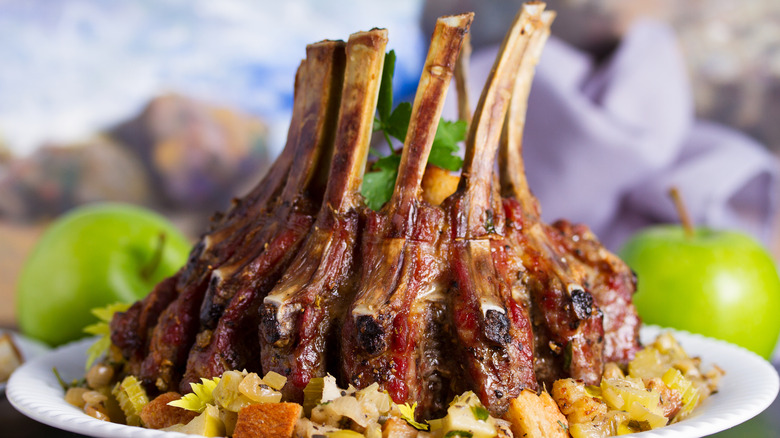Alton Brown's Trick For Prepping Crown Roast Without Twine
As the weather turns colder, there are a few classics that tend to be served during the holiday season: Thanksgiving turkeys, baked hams, prime rib roasts. But armed with Alton Brown's trick, you might consider serving a crown roast at your next gathering instead.
A crown roast, simply put, is the rib section of a pork or lamb loin cut so that one side of the bone is exposed, aka the French cut. The rack of ribs is wrapped in a circle, secured with butcher's twine, and cooked meat side down so that the exposed rib bones appear like a crown at the top (via RecipeTips.com). The inside of the crown is often filled with vegetables or stuffing that cook along with the roast.
Known for its elegant appearance when it comes out of the oven, as well as the tenderness of the meat, this recipe is sure to stun your dinner party guests. But what to do if you find yourself ready to cook and out of twine? Luckily for last-minute home cooks everywhere, as is often the case, Alton Brown has the answer.
For crown roasts, we like big bundts
In an Instagram post, Alton Brown explains if you're craving a crown roast but don't have any kitchen twine, you can use a bundt pan to hold it together instead.
Using a cake pan to cook a rib roast might seem a bit absurd, but as a concept, it checks out. The whole idea behind using butcher's twine — or "trussing" your meat — is to hold the dish together in a uniform shape; This ensures that the meat cooks evenly, per Martha Stewart. Placing the crown roast into a bundt pan should achieve the same cooking symmetry you'd strive for with butcher's twine, all without any fussy knotting. In addition (and depending on the style of your pan) a bundt pan would not only keep the crown roast in the correct shape, but the divots in the pan could be a good fit to stabilize the base of the ribs.
It might not come out of the oven looking as slick as when you use butcher's twine — and the hole in the center creates a problem if you planned to stuff your roast before cooking — but in a pinch, the effectiveness is nearly the same.

